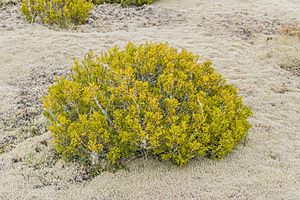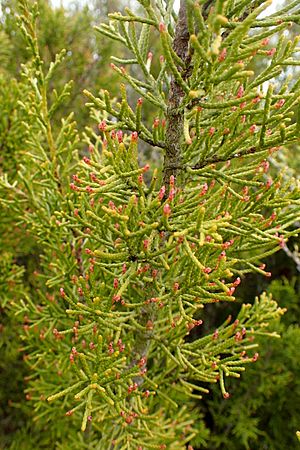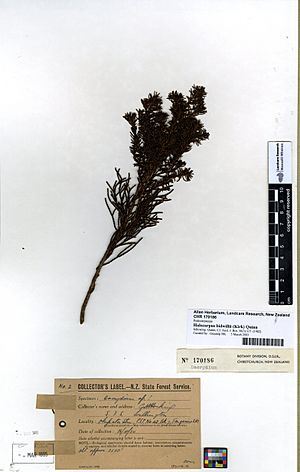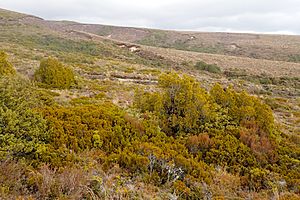Mountain pine facts for kids
Quick facts for kids Mountain pine |
|
|---|---|
 |
|
| Conservation status | |
| Scientific classification | |
| Genus: |
Halocarpus
|
| Species: |
bidwillii
|
| Synonyms | |
|
|
The Halocarpus bidwillii, also known as the mountain pine or bog pine, is a type of conifer tree. It belongs to the Podocarpaceae family. This plant is special because it grows only in New Zealand.
It is an evergreen shrub, meaning it keeps its leaves all year. It likes both wet, boggy areas and dry, rocky ground. It usually grows up to 3.5 m (11 ft) tall. Adult plants have small, scale-like leaves about 1–2 mm (0.039–0.079 in) long. These leaves grow in a spiral pattern around the branches. Young plants have soft, strap-like leaves that are 5–10 mm (0.20–0.39 in) long. The seed cones look like berries. They have a white, fleshy part called an aril around a single 2–3 mm (0.079–0.118 in) long seed.
Contents
- Discover the Mountain Pine
- Where Mountain Pines Grow
- Where Mountain Pines Like to Live
- Life Cycle of the Mountain Pine
- What Mountain Pines Need to Thrive
- Mountain Pine's Natural Challenges
- Naming the Mountain Pine
- How to Identify a Mountain Pine
- Uses of the Mountain Pine
- Mountain Pine as an Insect Fighter
- Images for kids
- See also
Discover the Mountain Pine
Even though it's called a pine, the mountain pine is more like a large shrub. It can grow from 2 to 12 feet (up to 3.5 meters) tall. Its trunk is usually short, often less than 1 foot (38 cm) thick. The bark is reddish-brown. Its leaves are green when fresh, but can turn brown or red when dry.
Sometimes, the branches of a mountain pine grow horizontally and form new roots. This creates a "bush" around the main plant. It can look like a huge, low tree or even a small forest. If the main plant dies, these new rooted parts can keep growing. This might be why it's called a "pine," as it can seem like many trees from a distance.
Young vs. Adult Leaves
The leaves of a mountain pine look very different depending on its age. Young plants have flat, linear leaves that spread out, much like a typical pine tree. As the plant gets older, its leaves become leathery and scale-like. These mature leaves are only 1-2 mm long and overlap, similar to fish scales.
Flowers and Seeds
From October to December, the mountain pine produces small male cones. These are 3-5 mm long and are reddish-brown. They grow at the tips of the scale-like leaves. You can sometimes see tiny white spots on them, which are stomata (tiny pores).
The fruit of the mountain pine has a dark brown or purplish-brown seed. This seed sits in a fleshy, waxy white cup. The seeds are small, about 2–3 mm long, and are usually shiny and oval-shaped.
Early Discoveries
When botanist Thomas Kirk first found this species, he noticed two different forms. One had flat, ribbed leaves and slender branches (called erecta). The other had distinct mid-rib leaves and stout branches (called reclinata). However, these differences are hard to spot. So, scientists today don't usually separate them into different forms.
Where Mountain Pines Grow
Native Home: New Zealand
The mountain pine is a species that is endemic to New Zealand. This means it naturally grows nowhere else in the world.
Finding Mountain Pines in New Zealand
You can find mountain pines all over New Zealand, from Coromandel in the North Island to the very south. The further south you go, the lower the altitude where they grow. In the North Island, they are found in places like Taupo county and the central volcanic plateau.
In the South Island, as the name suggests, they are common in mountains. You can see them in Nelson, Canterbury, and Otago, sometimes as high as 4500 feet (1370 meters) above sea level. They even grow at sea level on Stewart Island.
Where Mountain Pines Like to Live
The mountain pine can live in many different places. It mostly prefers cool, high-altitude areas, from mountains to subalpine regions. In these areas, the average temperature is about 8.5°C (47°F). The coldest month usually has an average low of -0.8°C (30.6°F). These places also get a lot of rain, about 2458 mm (96 inches) per year.
In the North Island, mountain pines are found mainly in mountain habitats. They usually grow between 600 and 1500 meters (about 2000-5000 feet) high. But they can also grow well in lowlands. For example, on Stewart Island, they thrive right at sea level.
Mountain pines are tough plants. They can grow in many types of soil. They do well in both wet, boggy environments and dry, stony ground. You can find them in wetland edges, frost flats, and riverbeds.
Life Cycle of the Mountain Pine
Like all conifers, the mountain pine's life cycle involves cones. Male and female flowers grow on separate plants. Male cones are 3-5 mm long and grow at the tips of branches. Female flowers grow alone or in pairs, just below the branch tips.
From Seed to Cone
It takes about 2–3 years for male conifers to become mature enough to produce cones. When they are ready, male cones appear during the flowering season. This usually happens from October to December, most often in October and November. In the North Island, cones tend to appear earlier in this period.
By late November, the reddish young cones turn brown and start to release pollen. Around the same time, ovules (which become seeds) grow at the branch tips. Once pollen fertilizes them, a white aril (fleshy covering) forms at their base.
Fruiting Season
Seeds develop over the next few months. The fruiting season is from February to June. By February, the green fruits are mature. They ripen in mid to early March, turning a dark purple or black color, like an eggplant.
The seeds themselves are small, only 3-4 mm long. They have regular grooves along their length. Mountain pine seeds are typically smaller and squatter than those of a similar species, H. biformis.
What Mountain Pines Need to Thrive
Mountain pines are very resistant to frost. They can handle temperatures colder than -7°C (19°F). They are also tough when it comes to soil. Like many conifers, they prefer poor soils that are low in nutrients and don't drain well. They often grow well in infertile bogs.
Even though they can survive very cold temperatures, mountain pines usually live in places with an average yearly temperature of 8.5°C (47°F). The average minimum temperature in the coldest month is -0.8°C (30.6°F). They also need a lot of rain, averaging 2458 mm (96 inches) per year.
Mountain Pine's Natural Challenges
Since mountain pines don't have true fruits, they have few predators. Most of their enemies are plant-eating insects.
Insect Pests
Four main types of insects can bother mountain pines: beetles, sucking bugs, caterpillars, and mites.
- Weevils, a type of beetle, feed on all plants in the Podocarpaceae family. Their larvae (young insects) live in decaying wood, including mountain pine wood.
- Scale insects, like Eriococcus dacrydii, live on the stems and leaves of Halocarpus species.
- A specific type of moth, Chrysorthenches halocarpi, uses the mountain pine as its host plant. Its caterpillars eat the shoots. If there are too many, the mountain pine can look bronze and its growth can slow down.
- Red mites, Tuckerella flabellifera, live on young mountain pine plants. They likely feed on the young leaves and wood.
Pine Wood Nematode Disease
Mountain pines can also get a disease from a tiny worm called the pine wood nematode. Infected trees have needles that turn yellow, brown, or red. They also wilt, and their sap stops flowing. In severe cases, the tree can die, and its wood turns blue. Treatments for this disease are usually done after the tree has died, by cleaning and cutting away the dead wood.
Naming the Mountain Pine
The name bidwillii honors John Carne Bidwill (1815-1853). He was an Australian botanist born in England. He became the first director of the Royal Botanic Gardens, Sydney.
The mountain pine hasn't always had its current scientific name. Thomas Kirk first discovered the species in 1877. He named it Dacrydium bidwillii, a name still sometimes used today. This naming was suggested by Sir Joseph Hooker. It wasn't until 1982 that C.J. Quinn proposed the current scientific name, Halocarpus bidwillii. This new name was based on how the plant's ovules (parts that become seeds) are shaped and positioned.
How to Identify a Mountain Pine
It's easy to spot a bog pine when it's producing fruit. The waxy white (or slightly yellowish) arils around the seeds are a clear sign.
When not fruiting, you can tell mountain pines apart from other Halocarpus species by their growth. They are smaller, multi-branched shrubs or small trees. Their leaves are weakly keel-shaped (like the bottom of a boat). Their young branches are more slender and initially square-shaped.
The seeds of mountain pine are also different from H. biformis, a species it's often confused with. Mountain pine seeds usually have clear grooves along their length, especially on the underside.
Uses of the Mountain Pine
When Thomas Kirk first described the mountain pine, he thought it had "little economic value," except maybe for firewood. He might not have known that it's best used for firewood without its bark!
The mountain pine is one of the few New Zealand conifers that can resist fire. This is mostly because of its thick bark. It can also regrow from its base after a fire. Besides firewood, the raw wood can be used for timber in buildings and for railway sleepers (the wooden beams under train tracks).
Mountain pine could also be used for decoration. Kirk noted its "attractive character" and symmetrical growth. He suggested it could be an ornamental plant in gardens. Other than decoration and firewood, no other major uses for mountain pine have been found so far.
Mountain Pine as an Insect Fighter
Scientists are now studying a cool trait of the mountain pine: its ability to fight insects. Extracts from mountain pine leaves contain special natural chemicals called diterpenes.
Experiments showed that extracts from mountain pine leaves were harmful to codling moths and somewhat harmful to houseflies. When powdered mountain pine leaves were added to the diet of codling moths, over 75% of them died. For houseflies, the death rate was 55-75%.
Mountain pine extracts have also been studied for their effect on lettuce seeds. Extracts from both young and adult mountain pines significantly reduced how many lettuce seeds sprouted. They also stopped the growth of root hairs. Scientists think this might be because mountain pines produce chemicals that stop other plants from growing nearby. This could explain why mountain pines often grow without other plants underneath them. More research is needed before mountain pine extract can be used commercially.
Images for kids
-
Male pollen producing strobili
See also
 In Spanish: Pino negro para niños
In Spanish: Pino negro para niños













